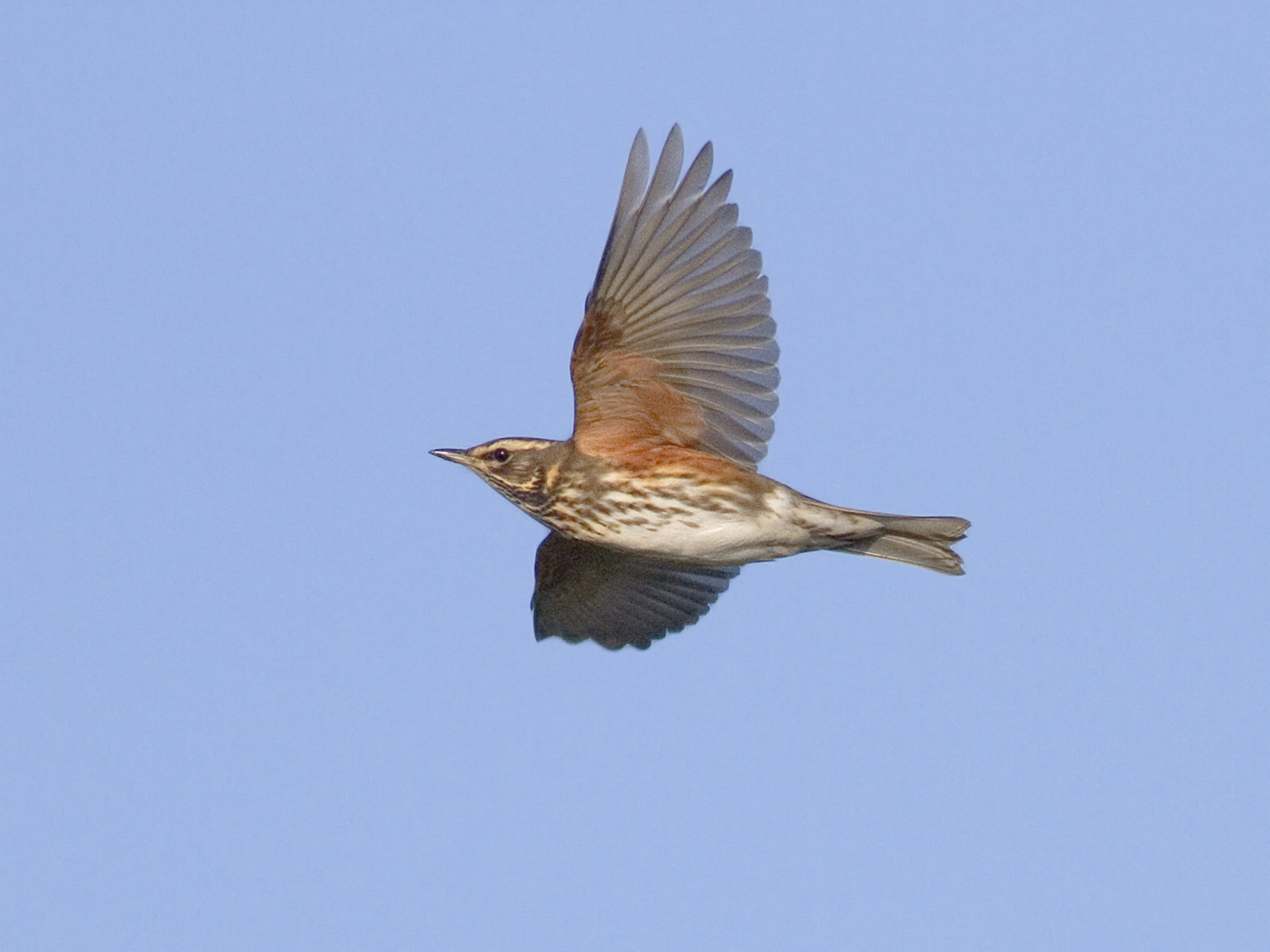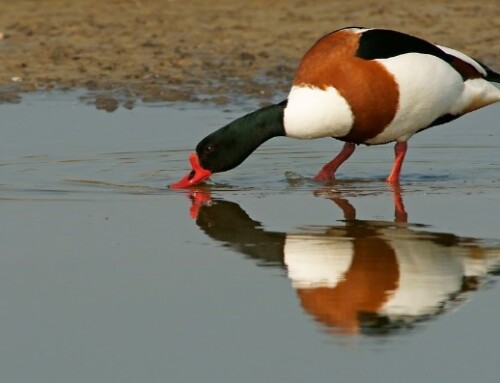LINKED PAPER
Nocturnal flight calling behaviour of thrushes in relation to artificial light at night. Gillings, S. & Scott, C. 2021 IBIS. DOI: 10.1111/ibi.12955 VIEW
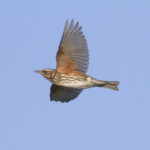 Each spring and autumn the night skies are filled with millions of migratory birds, moving between their breeding and wintering areas (Nussbaumer et al. 2021). Migrating at night might seem like the perfect strategy – many species can’t feed at night and flying under cover of darkness could reduce predation risk. But there is increasing evidence that artificial light at night (ALAN) from urban and industrial sites can have a disorienting influence on these migrants. Most of the evidence comes from North America where incidences of mass mortality (e.g. Loss et al. 2014) from birds colliding with skyscrapers are driving a Lights Out campaign.
Each spring and autumn the night skies are filled with millions of migratory birds, moving between their breeding and wintering areas (Nussbaumer et al. 2021). Migrating at night might seem like the perfect strategy – many species can’t feed at night and flying under cover of darkness could reduce predation risk. But there is increasing evidence that artificial light at night (ALAN) from urban and industrial sites can have a disorienting influence on these migrants. Most of the evidence comes from North America where incidences of mass mortality (e.g. Loss et al. 2014) from birds colliding with skyscrapers are driving a Lights Out campaign.
This is surely just a North American problem, right? The night skyline of many UK cities couldn’t be more different than those of New York or Chicago, with few (if any) high-rise towers of light drawing birds to their death. Since 2017, I have been recording the night flight calls of birds migrating over my home in suburban Cambridge, UK. The diversity and abundance of night migrants I’ve detected prompted one local birder to suggest that it was all down to the city lights. Could the artificial lighting in a modest UK city really draw birds in? In 2019 I had an opportunity to test this.
Audio clip 1 Nocturnal flight calls of at least three Redwings 1855, 08/11/2020, Cambridge © Simon Gillings
Of the many night migrants that call at night, the thrushes are by far the most abundant. The ‘tseep’ calls of Redwings will be a familiar sound (Audio clip 1) to any birder who has spent time outside on an autumn evening. By recording the rates of calling in different locations, I hoped to assess whether Redwings, Blackbirds and Song Thrushes were attracted to the city. Using a grant from the British Birds Charitable Trust, I purchased 10 AudioMoth passive acoustic recorders. A request through the Cambridge Bird Club identified a network of birders who were willing to host a recorder in their garden (Fig. 1). We deployed the recorders in a stratified manner to ensure that on any given night there were recorders along the lighting gradient, from the brightest parts of the city to the darkest rural hamlets.
 Figure 1 An AudioMoth in a case set to record the calls of migratory birds over a garden near Cambridge (© Simon Gillings).
Figure 1 An AudioMoth in a case set to record the calls of migratory birds over a garden near Cambridge (© Simon Gillings).
Depending on the prevailing weather, waves of thrushes arrive into East Anglia throughout October and November, so the recorders were deployed on a two week rotation through late September to mid November 2019. At the time, it was not possible to configure the recorders to trigger in response to a thrush call, so they ran continuously from 6pm to 6am, generating 3432 hours of audio recordings. Counting thrush calls manually would have been prohibitively time consuming, so with funding from the Esmée Fairbairn Foundation, and a BTO sabbatical, I worked with Dr Chris Scott to develop an artificial neural network to automatically detect and identify thrush calls.
Neural networks have proven extremely effective and efficient at detecting and identifying species in soundscapes. To be accurate, they need to be trained on large reference libraries of known calls. Fortunately, I have amassed a large collection of flight calls myself and I supplemented this with clips shared by other sound recordists in Europe. Labelling these is quite time consuming but still quicker than manually processing all 3500 hours of audio. The audio library consisted of 12,466 Redwing training samples, 4253 Blackbird samples and 3378 Song Thrush samples, plus 59,545 non-target sounds, comprising 22,043 non-avian sounds and 37,502 calls of stationary birds and night flight calls of non-target species. Using these and Chris’s knowledge of neural networks, we developed a convolutional neural network that was able to detect up to 94% of thrush calls when applied to independent data. We judged this acceptable and used the algorithm to process all 3432 hours of audio, detecting 1404 Blackbird calls, 7386 Redwing calls and 2157 Song Thrush calls.
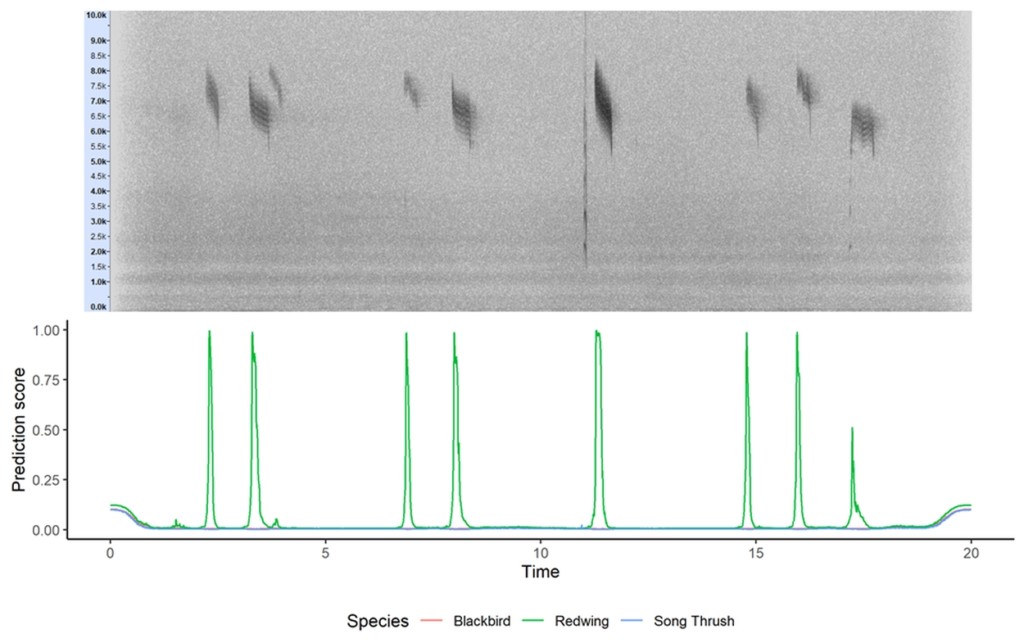 Figure 2 Illustration of predictions made for an audio clip. The upper spectrogram shows 20 seconds of audio with nine Redwing calls (same as Audio Clip 1). The lower panel shows score predictions for the likelihood of each species being present through the recording. Peaks in the green line indicate where the neural network has detected a Redwing call. The network correctly predicted no Blackbird or Song Thrush calls.
Figure 2 Illustration of predictions made for an audio clip. The upper spectrogram shows 20 seconds of audio with nine Redwing calls (same as Audio Clip 1). The lower panel shows score predictions for the likelihood of each species being present through the recording. Peaks in the green line indicate where the neural network has detected a Redwing call. The network correctly predicted no Blackbird or Song Thrush calls.
A good test of whether the neural network was accurately detecting thrushes was to compare the seasonal pattern of thrush detections from the AudioMoths with equivalent manually-processed recordings from my own garden. Sure enough, on the nights when there was a big thrush passage over my garden, the AudioMoths across the region, analysed with the neural network, showed the same pattern. For example, all the recorders running in late October–early November detected a large pulse of Blackbirds on the night of 29 October (Fig. 3). Having established that neural network was effective, we finally related the calling rate to the average artificial night time illumination at each location, derived from satellite imagery. Once we controlled for each species’ seasonal pattern of occurrence there was a strong effect of ALAN, with up to five times more calls detected over the bright city compared to the dark villages. This work would not have been possible without the assistance of the birders who hosted recorders and the sound recordists who shared their call library: thank you all.
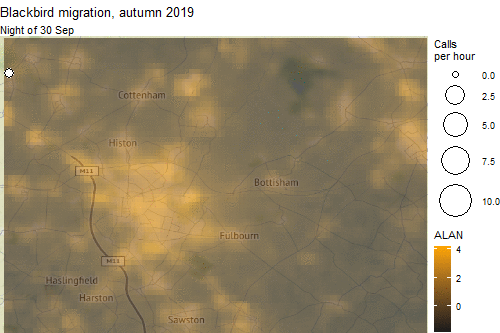
These results confirm that even a modest-sized UK city without high rise buildings is capable of influencing the behaviour of nocturnal migrants. For city dwellers this is great news: for once we live in the best place to experience nocturnal migration! But there is a serious side to this: levels of artificial lighting in a typical UK city are already sufficient to affect bird migration. We may not (yet) have many skyscrapers to inflict mass mortality, but changing flight paths, causing disorientation and enforcing stopovers in suboptimal habitats are all potential outcomes that could add to the pressures experienced by migratory birds, many of which are in decline. Perhaps with more research and awareness of ALAN effects on European migratory birds we can avoid the need for ‘Lights Out’ campaigns by not turning them on in the first place.
References
Nussbaumer, R., Bauer, S., Benoit, L., Mariethoz, G., Liechti, F., Schmid, B. 2021. Quantifying year-round nocturnal bird migration with a fluid dynamics model. bioRxiv VIEW
Loss, S.R., Will, T., Loss, S.S. & Marra, P.P. 2014. Bird–building collisions in the United States: estimates of annual mortality and species vulnerability. Condor 116: 8–23. VIEW
Image credit
Top right: Redwing Turdus iliacus © Tim Jones


